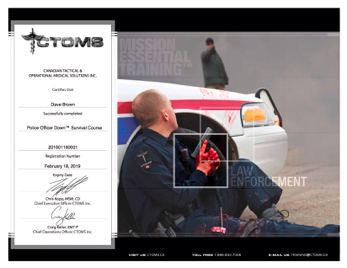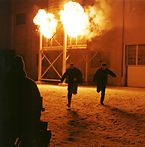The Next Three Minutes
Why every officer should carry an individual first aid kit
by Dave Brown
A bright flash; a loud boom; a sudden searing pain - it doesn't matter exactly how it happened. All that matters right now is that blood is rapidly pouring from a gunshot wound and what you did to prepare for this moment is going to dictate whether the next three minutes are the last minutes of your life or not.
Thankfully, backup is right behind you, EMS is five minutes away and a fully-equipped trauma room is 20 minutes down the road, but if bleeding from a serious gunshot wound is not controlled right away, you could be dead in half that time.
If you carry a firearm for a living or spend any amount of time training on shooting ranges, you should consider carrying an individual first aid kit (IFAK) in an easily accessible place on your person. An IFAK is not for general first aid kit, nor is it primarily designed to help others. It is designed to be a compact kit containing a minimal amount of gear to, firstly, use on yourself to help save your life, or secondly, for others to use on you if you are disabled or unconscious.
The goal of a good IFAK should not be “how much can I stuff in there,” but rather, “what is the minimum amount of gear that I need to carry on my person to keep me alive for those first few minutes.”
An IFAK is a singular-purpose first aid kit designed specifically to stop uncontrolled bleeding from a penetrating gunshot or stab wound on your body. (This is why they are sometimes termed blow-out kits.) The philosophy of a compact IFAK that is carried with you at all times is simple – the most well-equipped first aid kit in your vehicle may be too far away when you need it the most.
During active shooter situations, you may be surrounded by people who can help, but if there is no Tactical Medic on your team, EMS may be forced to stay back until shooters have been neutralized and the zone cleared. Consider yourself on your own for the next few minutes.
Not every IFAK is going to be perfect setup for everyone. As always, let your mission dictate your gear. The science of combat first aid has improved significantly in the past few years, and officers can take advantage of these advancements. A few carefully selected items can now be stored in a kit smaller than the size of a double AR magazine pouch or even spread amongst a flat kit plus a separate tourniquet pouch.
What works
Tourniquets save lives. This lesson has been reinforced from decades of conflict in Iraq and Afghanistan, the streets of Boston and Las Vegas and multiple times here in Canada. Lives have been saved by the quick application of a tourniquet to an extremity wound that would have otherwise resulted in the loss of consciousness within seconds, and death within minutes.
If there is one item in an IFAK that could be said to have advanced more than any other through the study of combat medicine and the science of casualty care, it would be the modern combat tourniquet. Once considered a necessary part of every soldier’s kit in the early days of the twentieth century, it was almost forgotten about for decades until the 1990s when a United States Special Operations medical research project was undertaken with the goal of improving trauma outcomes through optimization of care rendered in tactical environments. Their research on pre-hospital trauma care resulted in an article titled, ‘‘Tactical Combat Casualty Care in Special Operations,’’ published as a supplement to the August 1996 issue of Military Medicine.
The project’s core principles for Tactical Combat Casualty Care (TCCC) are to avoid preventable deaths with effective gear, better training and good tactics. Their guidelines were customized primarily for use on the battlefield and concentrated on the three most common causes of preventable death in combat:
- extremity hemorrhage (60% of deaths)
- tension pneumothorax (33% of deaths)
- airway obstruction (6% of deaths)
In subsequent years, percentages of death due to tension pneumothorax have fallen significantly due to advances in body armour.
The same applies to police officers. Consider today that extremity hemorrhage will likely be your biggest concern. While combat soldiers may have to deal with hospital care that is hours away, police officers have sometimes been suddenly thrust onto streets that look more like a combat zones and had to deal with situations where help is not always blocks away. This is why the lessons learned from combat are also important on the streets.
Equipment does not replace tactics, and stopping the threat will always have first priority. The best medicine is superior firepower. That means winning the fight as quickly and efficiently as possible. After that, is time to look after the fallen.
So if you are one of the fallen, your best friend for the next few minutes might just be that IFAK on your belt.
What to carry
Pressure on a wound is always your first line of defence, but if you are suffering from uncontrolled bleeding resulting from a gunshot wound, you need help to apply and maintain that pressure. This is why most well-equipped kit in the world back in your car is not as good as a minimal kit you have on your person. So if you are selecting your own kit or in charge of outfitting others, you should have a good understanding of what works, and – almost as important – what you don’t need.
My research into the science of combat medicine, plus talking to combat medics, EMS technicians and trauma room physicians has taught me one very important lesson in choosing what to include in a kit – the more experience one has with real gunshot wounds, the less gear they believe people need to carry in their kit.
It may seem counter-intuitive, but experienced medics know what works and what to leave out. Unless your job is tactical or emergency medicine, they feel that one shouldn’t carry more than one can pack in one or two small pouches, and one shouldn’t carry anything that they are not trained to apply.
This greatly simplifies our selection process. Based on the fact that hemorrhage bleeding is the number one cause of preventable combat deaths, there are three main possibilities to address in those first few minutes: a gunshot wound to an extremity; a gunshot wound to the chest; or a gunshot wound that pierces an artery. So while tension pneumothorax (a buildup of air from a sucking chest wound) is the next preventable cause of death on the battlefield, it probably won’t kill you in the first 30 minutes as much as uncontrolled bleeding will in two to three minutes. This is why most police officers in Canada can generally leave pneumothorax for EMS and worry primarily about stopping the rapid bleeding or simply sealing off a hole in the chest to be dealt with better later on in the trauma room.
A minimal kit can therefore be as few as five basic items:
- nitrile gloves
- tourniquet
- pressure bandage
- hemostatic gauze
- adhesive chest seal
Add a means of cutting away clothing and maybe a pen to write down the time of application on the tourniquet, and you have your basic IFAK.
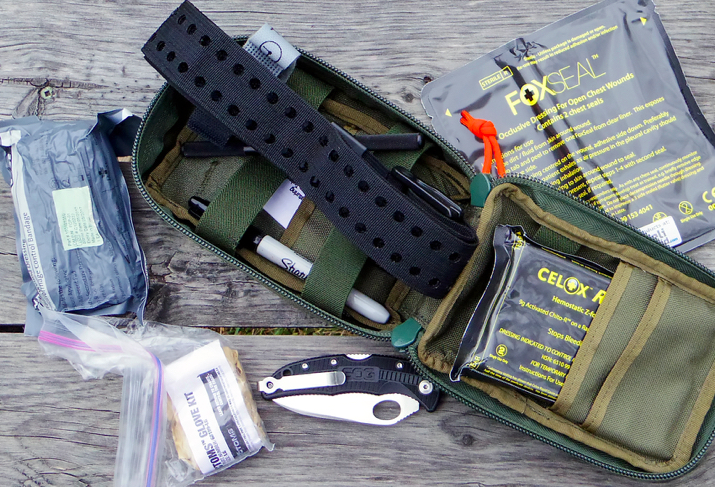
Basic IFAK: tan gloves, 4-inch Israeli bandage, SAM XT tourniquet, Celox Rapid Z-fold combat gauze, Fox chest seal
Gloves
Nitrile gloves are a necessity. Even if dealing with your own injuries, they will help pack gauze deep into a bullet wound. Tan or blue colored gloves are better than black because they show the presence of blood more clearly during a rapid body survey.
Tourniquets
A tourniquet should be the first thing you see when you open your IFAK. Applying direct or indirect pressure is the traditional first line of defence for a gunshot wound, but it may not always be practical to keep applying pressure to yourself or others if still under fire. Plus, if bleeding is serious you can lose consciousness quickly. If you are not sure, apply it. If wounded in an arm or leg, you may not have time to wait to see if pressure, gauze or bandages stop the bleeding, so get one on right away.
High and tight are the keywords. They should be applied two finger widths proximal (toward the centre of the body) to the wound. If the tourniquet will be around a joint, apply it above the joint. It should be tight enough to stop the bleeding and when applied properly, you should not be able to stick three fingers under the strap.
The modern combat tourniquet is quick to apply, effective enough to stop the bleeding and wide enough to minimize the possibility of permanent damage even if left on for hours. They also require minimal training, but remember that unwrapping the straps when you need one is a really poor time to be reading about how to apply it. Train and practice with it before you need it.
Tourniquets will cause pain when applied, and even more pain when released but this is where proper training is important. Pain is not an indication it is on too tight or that nerve damage is occurring. Plus, a little pain is better than a lot dead.
Tourniquets should be left on until professional help arrives. They should NOT be loosened on regular basis to restore circulation. Every time they are loosened, there is a risk of restarting bleeding, especially if arterial, that may not be stopped as easily the second time. If a second tourniquet needs to be applied, for example against the skin when the first one was applied over clothing during a direct threat situation, the second tourniquet should be applied above the first one. Leave both on.
Modern tourniquet designs and proper training reduce the risk of complications to the point that one should be able to save both life and limb. This is why many agencies in Canada are now issuing tourniquets to every officer. If the gunshot wound is to an extremity and the bleeding is severe, get it on fast, proximal to the wound and tight.
In my research, I have found three different levels of pre-hospital tourniquets:
- High quality combat-tested tourniquets such as Composite Resources Combat Applications Tourniquet (C-A-T), the Special Operations Forces Tactical Tourniquet Wide (SOF-TT Wide) and the SAM Extremity Tourniquet (SAM XT.) The C-A-T is slightly smaller and lighter, thanks to its composite rod versus the aluminum rod of the SOF-TT W. The SAM XT has a unique ratchet system that automatically locks when the correct tension is reached, and is very fast and simple to apply. All three are extremely well made. The C-A-T is now standard issue for Canadian and U.S. troops, and has been issued to millions of soldiers in the United States, Canada and Britain since 1995.
- No-name knock off (what I call "white label") brands that copy the C-A-T design and are manufactured by medical supply houses in China. Primarily sold in volume by tender, there is no evidence that they may fail to work as designed.
- Imitation C-A-Ts designed for kids playing airsoft games. These are cheap counterfeits made by toy companies in China that one can buy for $14. They are designed only for the look and should never be used in a real first aid kit. Be aware that counterfeit tourniquets may be poor quality but are such good imitations of the real thing that they have fooled more than one soldier who purchased one off eBay.
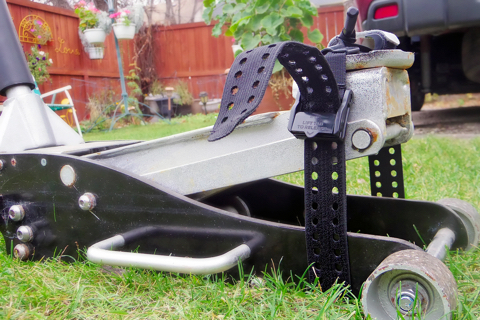
Testing a tourniquet to destruction. Even a 2-ton floor jack could not break the SAM Medical SAM XT tourniquet!
Combat Bandages
Pressure or “combat” bandages are designed to wrap tightly around a wound and apply needed pressure to stop bleeding. They can be applied where a tourniquet is not appropriate. Stored in a highly-compressed state, they usually come in 4-inch and 6-inch widths. The best ones are the Israeli bandages (most of which are still made in Israel) and the modular Olaes bandage, named after U.S. Special Forces combat medic Army Staff Sgt. Tony Olaes who was killed September 20, 2004 during Operation Enduring Freedom in Afghanistan.
Applied properly, they are capable of significant compression. One 4-inch Israeli (commonly called an “Izzy”) or 4-inch flat-packed Olaes fits very nicely into my compact IFAK, and I keep several more 4-inch and 6-inch Israelis plus an Olaes bandage in a larger mobile vehicle kit.
Pressure bandages are not designed to soak up blood for a serious or arterial wound; they are designed to apply pressure over top of tightly-packed gauze in the wound. If a pressure bandage soaks through quickly, it is an indication that the wound was not packed tight enough and it should be removed and new gauze applied.
When you use gauze to pack a wound and a pressure bandage over top, keep the empty packet from the gauze and wrap it underneath the last two layers of the bandage so emergency room physicians know what you used.
Hemostatic Gauze
Hemostatic products speed clotting of blood, and this is where significant improvements have been made the past few years. Original products came in a powder or crystal form that was sprinkled over the wound and then sealed or packed with gauze. The problem was that the early versions could cause severe burns through a chemical reaction. Emergency room physicians absolutely HATED these older hemostatic agents because of the possibility of burns and the difficulty in debriding wounds. They also found that people would use them when they got a simple fishhook stuck in their thumb and not for bleeding that could not be otherwise stopped through pressure.
Hemostatic agents have now been removed from most military IFAKs, and replaced by the much better hemostatic-impregnated gauze. QuikClot Combat Gauze and Celox Rapid z-fold gauze are among the most well-known products currently on the market. The gauze can be packed tightly into wounds to control bleeding or folded into a pad and placed over shallow wounds such as in the head, torso or neck where compression bandages don’t work well.
QuikClot Combat Gauze is impregnated with kaolin, an inorganic mineral that accelerates the body’s natural clotting ability and produces no exothermic reaction. It works on contact with blood to enhance the blood’s natural clotting mechanism within seconds.
Celox uses a natural material called chitosan, a byproduct of shellfish. When chitosan contacts blood, it quickly swells and sticks together to form a gel seal. It does not generate heat, and any leftover material is easily absorbed by the body. Celox has also been extensively tested on people, many with shellfish allergies, with no ill effects ever reported.
Hemostatic gauze must be packed tight to the wound and must make contact with blood. It cannot be reused and if a wound must be repacked, it should be removed completely and new hemostatic gauze applied. If more gauze is needed to increase the pressure in the wound cavity, regular gauze may be packed over top of hemostatic gauze.
Chest Seals
One place you do not need any holes – as if there were any place on your body that you do – is the chest. This includes from the belly-button area to the clavicle, on all four sides. A bullet hole here creates an opening in the chest area and lungs where air being sucked in through the hole is just as likely to kill you as the bleeding. (This is why they are often referred to as a “sucking” chest wound.)
A chest seal is an adhesive plastic disk designed to stick to the skin and quickly seal up bullet holes. The best ones come in pairs, because if there is one hole in your chest, there is likely two. They use a very high adhesive seal that will effectively stick to hair, blood and wet skin.
Before the advent of good chest seals, medics would sometimes use old EKG probe patches or plastic sheets from bandage wrappers taped on three sides, but there is no reason to waste time doing that today. The only downside to the seals is the awkward size of packaging meant folding before it fits in a compact IFAK.
Adhesive chest seals must be licensed by Health Canada as a Class 2 medical device, and the two most popular ones are the Halo Chest Seals and the Fox Seal, from the same maker as Celox.
What you don’t need
Many of the experts I talked to have seen valuable space in an officer’s IFAK taken up with unnecessary gear – everything from nasopharyngeal airways, chest decompression needles, and even scalpels. Understand that you are not surrounded by combat soldiers who have all been trained in emergency first aid. You may be by yourself, or you may be surrounded by people with minimal or no training. Your kit is designed to be used on yourself first and used by others on you second.
For example, before anyone decides to put a chest needle into their kit, I always suggest they look around at the other people on the shooting range and decide for themselves if they want any of these folks jabbing long sharp needles into their chest close to their heart. Chest needles and airways are two items that are difficult for even the experts to apply and they usually aren’t something that needs to be done in the first ten minutes, especially if you quickly occlude a chest wound with chest seals.
First aid trainers with real life gunshot-wound experience will usually say that outside of trauma rooms, needle or valve decompression of the chest is not always very effective, has a high complication rate and is better done as a chest drain at the hospital anyway.
Another solution for some might be to split components; carrying a tourniquet in an easily accessible pocket, and then a slimmer kit with pressure bandage, chest seals and hemostatic gauze tucked inside body armor or around an ankle.
Vehicle Kit
I spend a lot of time on shooting ranges, so I carry a second larger kit in my vehicle for more of the same, plus other items that are important but not necessarily critical for those first few minutes:
- 5 more pairs nitrile gloves
- Additional C-A-T tourniquet
- 4-inch Olaes modular bandage
- 6-inch Israeli compression bandage
- QuikClot Combat Gauze
- 2 packs H&H compressed sterile gauze
- EMS shears
- CPR mask
- 12 4x4 gauze pads
- 2 Purell cleansing and sanitizing towels
- 2 packs Water-Jel burn dressing
- All Weather space blanket
- Head-mounted LED light
- Reflective traffic vest
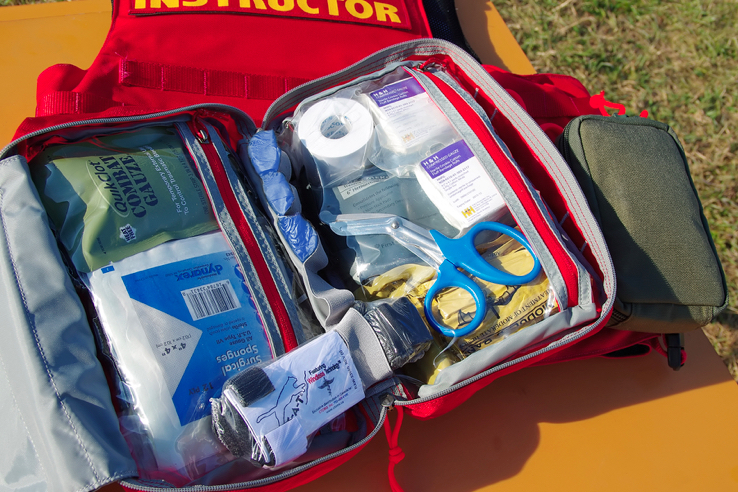
This has been a review of some of the items I would recommend. I am not a medic or a first aid expert. In my career, I deal with firearms daily. I am trained in officer-down first aid and I researched the top-quality products on the market today but what works for me isn’t going to work for everyone. The science of combat medicine is constantly evolving and new products are being introduced almost every day. This article is designed to get you thinking about what you would carry in your individual first aid kit and what you might need to save your life for those first few minutes.
- Dave Brown © 2018